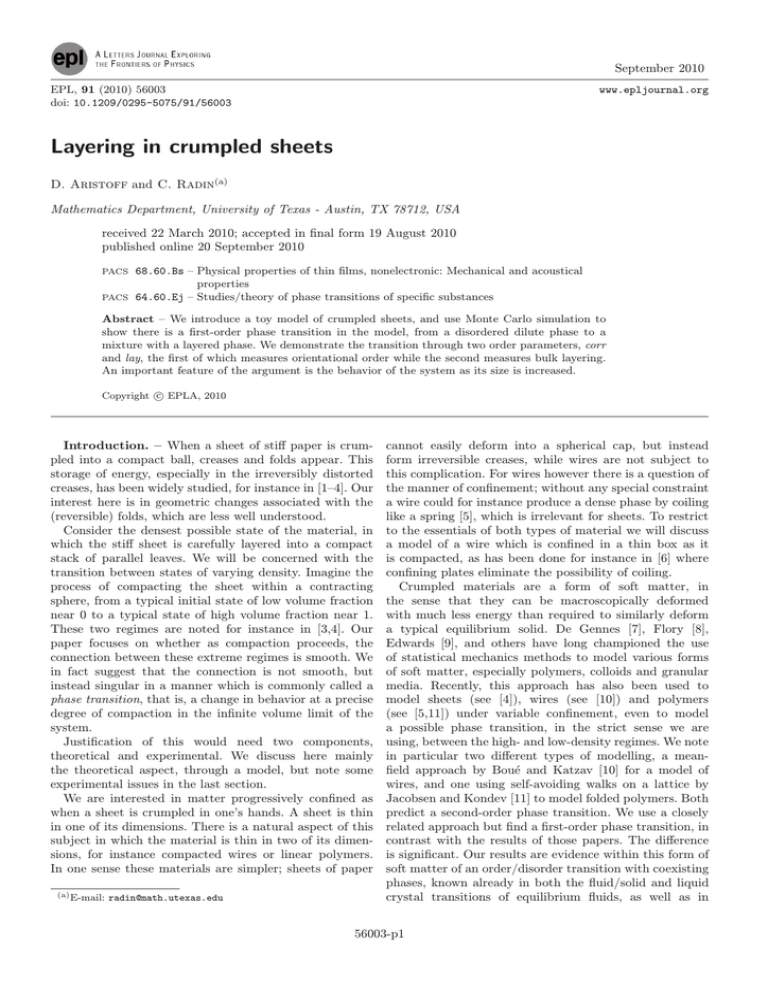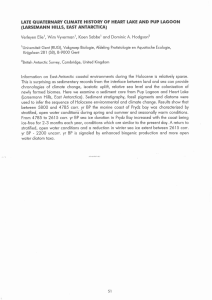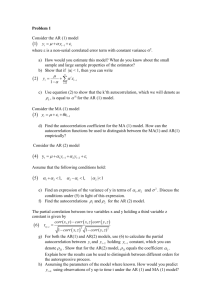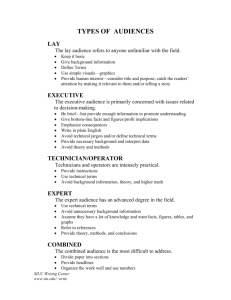Layering in crumpled sheets
advertisement

September 2010
EPL, 91 (2010) 56003
doi: 10.1209/0295-5075/91/56003
www.epljournal.org
Layering in crumpled sheets
D. Aristoff and C. Radin(a)
Mathematics Department, University of Texas - Austin, TX 78712, USA
received 22 March 2010; accepted in final form 19 August 2010
published online 20 September 2010
PACS
PACS
68.60.Bs – Physical properties of thin films, nonelectronic: Mechanical and acoustical
properties
64.60.Ej – Studies/theory of phase transitions of specific substances
Abstract – We introduce a toy model of crumpled sheets, and use Monte Carlo simulation to
show there is a first-order phase transition in the model, from a disordered dilute phase to a
mixture with a layered phase. We demonstrate the transition through two order parameters, corr
and lay, the first of which measures orientational order while the second measures bulk layering.
An important feature of the argument is the behavior of the system as its size is increased.
c EPLA, 2010
Copyright Introduction. – When a sheet of stiff paper is crumpled into a compact ball, creases and folds appear. This
storage of energy, especially in the irreversibly distorted
creases, has been widely studied, for instance in [1–4]. Our
interest here is in geometric changes associated with the
(reversible) folds, which are less well understood.
Consider the densest possible state of the material, in
which the stiff sheet is carefully layered into a compact
stack of parallel leaves. We will be concerned with the
transition between states of varying density. Imagine the
process of compacting the sheet within a contracting
sphere, from a typical initial state of low volume fraction
near 0 to a typical state of high volume fraction near 1.
These two regimes are noted for instance in [3,4]. Our
paper focuses on whether as compaction proceeds, the
connection between these extreme regimes is smooth. We
in fact suggest that the connection is not smooth, but
instead singular in a manner which is commonly called a
phase transition, that is, a change in behavior at a precise
degree of compaction in the infinite volume limit of the
system.
Justification of this would need two components,
theoretical and experimental. We discuss here mainly
the theoretical aspect, through a model, but note some
experimental issues in the last section.
We are interested in matter progressively confined as
when a sheet is crumpled in one’s hands. A sheet is thin
in one of its dimensions. There is a natural aspect of this
subject in which the material is thin in two of its dimensions, for instance compacted wires or linear polymers.
In one sense these materials are simpler; sheets of paper
(a) E-mail:
radin@math.utexas.edu
cannot easily deform into a spherical cap, but instead
form irreversible creases, while wires are not subject to
this complication. For wires however there is a question of
the manner of confinement; without any special constraint
a wire could for instance produce a dense phase by coiling
like a spring [5], which is irrelevant for sheets. To restrict
to the essentials of both types of material we will discuss
a model of a wire which is confined in a thin box as it
is compacted, as has been done for instance in [6] where
confining plates eliminate the possibility of coiling.
Crumpled materials are a form of soft matter, in
the sense that they can be macroscopically deformed
with much less energy than required to similarly deform
a typical equilibrium solid. De Gennes [7], Flory [8],
Edwards [9], and others have long championed the use
of statistical mechanics methods to model various forms
of soft matter, especially polymers, colloids and granular
media. Recently, this approach has also been used to
model sheets (see [4]), wires (see [10]) and polymers
(see [5,11]) under variable confinement, even to model
a possible phase transition, in the strict sense we are
using, between the high- and low-density regimes. We note
in particular two different types of modelling, a meanfield approach by Boué and Katzav [10] for a model of
wires, and one using self-avoiding walks on a lattice by
Jacobsen and Kondev [11] to model folded polymers. Both
predict a second-order phase transition. We use a closely
related approach but find a first-order phase transition, in
contrast with the results of those papers. The difference
is significant. Our results are evidence within this form of
soft matter of an order/disorder transition with coexisting
phases, known already in both the fluid/solid and liquid
crystal transitions of equilibrium fluids, as well as in
56003-p1
D. Aristoff and C. Radin
of µi+1 . The basic Monte Carlo step is the following. From
a given configuration C ∈ A, we choose a random subpath
σd of length d. We then consider all configurations C ′ ∈ A
obtainable from C by replacing σd with a path σd′ while
leaving the rest of C unchanged. Here σd and σd′ have the
same starting points and ending points, and the length
d′ of σd′ is bounded, d1 d′ d2 . We then choose C ′ ∈ A
with relative acceptance probabilities determined by mµi .
For the 1 : 2 model we choose, with probability 0.5, either
d = 1 and d1 = d2 = 2, or d = 2 and d1 = d2 = 1. For the
1 : ∞ model we take d = 5, d1 = 1 and d2 = 9.
For each measurement meas we use a standard autocorrelation function to find a “mixing time” at each µi ,
Fig. 1: (Color online) A self-avoiding polygon on L; orientation which we define as the smallest value of t such that the
not indicated.
autocorrelation
m−t
granular matter [12,13]. This suggests a basic, unified
1
(meas(Ci ) − λ) · (meas(Ci+t ) − λ) (3)
treatment of the phenomenon in a variety of materials
2
(m − t)σ i=1
both in and out of equilibrium.
In the last section we compare our results with previous falls below zero. Here C , . . . , C is the Monte Carlo
1
m
work in [4,10,11] and discuss experimental verification.
chain of configurations corresponding to the simulation of
2
The model and results. – For a fixed integer
n µi , and λ and σ are the (sample) average and variance
√
consider the triangular lattice L = {(a + b/2, b 3/2): of meas over that chain. We found that for each of our
(a, b) ∈ (Z/nZ)2 } with periodic boundary conditions. measurements meas (described below), our simulations
of each µi were on average at least 20 times as long as
Note that this space is homogeneous and isotropic.
the
corresponding mixing times. We therefore believe
Let A be the set of oriented self-avoiding closed walks
our
simulations
sample the target distribution given by
(polygons) on L, its elements being called walks or config. We obtain error bars from the Student’s
eq.
(2)
at
each
µ
i
urations; see fig. 1. If a walk C ∈ A changes direction at
t-distribution
by
running 200 independent copies of the
a vertex, we say there is a bend there. If it changes by
simulation.
±2π/3, we call the bend large; if it changes by ±2π/6 we
The infinite volume limit is important in our considercall it small. We define Bs (C) as the number of small bends
in C and Bℓ (C) as the number of large bends in C. Assign- ations, since there cannot be a transition in a model of
ing the energy es to each small bend and eℓ to each large finite size. In our simulations we approximate the infinite
volume limit by measuring “bulk” effects, that is, features
bend, we define the total energy of configuration C by
which scale with the size of the system. We introduce two
E(C) = Bs (C)es + Bℓ (C)eℓ ,
(1) such measurements, lay and corr, to detect the spontaneous symmetry breaking and layering which may occur
and denote the model with energy parameters es and eℓ at large µ. To detect “bulk” edge correlation, we define
by es : eℓ .
corr(C) as follows: choose a random edge in C and define
Because it is harder to simulate our model at fixed corr(C) as the proportion of edges in C which are parallel
density and/or fixed energy, we use variables β to fix the to it. Since the model is isotropic we expect corr(µ) to be
average of energy E, and µ to fix the average of particle identically 1/3 for small µ in the infinite volume limit.
(edge) number N , assigning the probability mµ (C) for any
To detect “bulk” layering we define lay(C) as the size
C ∈ A:
of
the largest parallelogram centered at the origin in C
e−β[E(C)−µN (C)]
,
(2) which contains an 80% perfectly layered region; lay(C) is
mµ (C) =
Z
then normalized by the system size. (A perfectly layered
where Z is the normalization. (We suppress dependence region consists of parallel line segments with no gaps or
on the system size.) Since we will only study isotherms bends.) We expect that for small µ, lay is identically zero
and can choose the energies eℓ and es in the model, we fix in the infinite volume limit. Note that the choice of 80% is
β = 1 without loss of generality. We have simulated 1 : 2 rather arbitrary; any percentage significantly above 33%
and 1 : ∞ with values of µ varied to examine a range of should detect bulk layers.
densities, and found the same qualitative results, which
The data, from systems of volume 402 = 1600, 602 =
we present below.
3600, 802 = 6400 and 1002 = 10000, gives strong evidence
To simulate the model at µ-values µ0 < µ1 < . . . < µl−1 , that in the infinite volume limit corr(µ) is identically
we start with µ = µ0 and a configuration which is a cycle 1/3 for µ < µ∗ , and that corr(µ) > 1/3 for µ > µ∗ , where
with 6 edges. The end configuration in the simulation of µ∗ ≈ 0.63 for the 1 : 2 model and µ∗ ≈ −0.2 for the 1 : ∞
µi is taken as the starting configuration in the simulation model. Furthermore the data strongly suggests that lay is
56003-p2
Layering in crumpled sheets
Fig. 2: (Color online) Data from the 1 : 2 model. a) Correlation vs. µ, for volumes 402 through 1002 , where the horizontal line
represents corr = 1/3; b) layer size vs. µ, for volumes 402 through 1002 . Error bars in both insets represent 95% confidence
intervals for volume 1002 , and for low µ are smaller than the data circles.
identically zero below µ∗ , but positive above µ∗ , showing
the emergence of bulk layers above µ∗ . See figs. 2, 3
and 4, 5, 6 with error bars in the insets.
Our argument for a phase transition is not based
on any visibly developing kink in the graphs of the
order parameters corr and lay. Instead, we argue that
in the infinite system our order parameters, lay and
corr, are identically 0 and 1/3, respectively, at low µ
(indicating disorder), but rise above these values at high µ.
We conclude that lay and corr are not analytic, since
an analytic function which is constant on an interval
is constant everywhere. Because corr and lay capture
relevant physical information about the system we can
reasonably call this a phase transition.
The rise of lay above zero indicates that there are
coexisting layered and disordered phases; this is why we
call the transition first order. Such a transition would
imply a discontinuity in φ(µ) (see fig. 7). We note that
the graph of φ(µ) does not clearly show a developing
discontinuity; however, this is expected since the systems
are finite and the plotted values of µ do not extend above
the coexistence region. For this reason our argument for a
first-order phase transition relies solely on the behavior of
corr and lay.
Discussion of results. – We have introduced and
simulated a toy model for the folding of a wire which
is held in a thin box as it is progressively compacted.
In the model, bulk folding begins to emerge at a sharp
volume fraction as the material is compacted, just as,
experimentally, bulk solid begins to emerge at a sharp
volume fraction in the freezing transition of equilibrium
56003-p3
D. Aristoff and C. Radin
Fig. 3: (Color online) Data from the 1 : 2 model. Snapshots of a loop in available volume 1002 in equilibrium at µ = 0.6 in a),
and µ = 0.67 in b).
Fig. 4: (Color online) Data from the 1 : ∞ model. a) Correlation vs. µ, for volumes 402 through 1002 , where the horizontal line
represents corr = 1/3; b) layer size vs. µ, for volumes 402 through 1002 . Error bars in both insets represent 95% confidence
intervals for volume 1002 , and for low µ are smaller than the data circles.
56003-p4
Layering in crumpled sheets
Fig. 5: (Color online) Data from the 1 : ∞ model. Snapshots of a loop in available volume 1002 in equilibrium at µ = −0.3 in
a), and µ = −0.1 in b).
Fig. 6: (Color online) Data from the 1 : ∞ model with hard-wall boundary conditions. Snapshots of a loop in available volume
1002 in equilibrium at µ = −0.3 in a), and µ = −0.1 in b).
fluids. This analogy has previously been used to model
the behavior of other types of soft matter, in particular
colloids [14] and the random close packing of granular
matter [12,13].
As noted in the Introduction this paper is only one in a
long history of modelling soft matter, not in thermal equilibrium, by the methods of equilibrium statistical mechanics. Such efforts are sometimes justified by assuming an
external energy source, perhaps a vibration of the material, which might enable the microstate of the material to
effectively optimize within the ensemble.
We next compare our model to three others. In [11]
Jacobsen and Kondev analyze the Flory model [15] of
strongly confined polymers using self avoiding walks on a
2-dimensional square lattice. Their model only considers
walks which fill the confining region, that is, they are all
of density one, but the model incorporates a parameter,
which might be thought of as temperature, by which the
ensemble average of the energy of the walks can be varied.
They find a 2-dimensional “melting” phase transition by
varying the temperature, or, equivalently, the strength of
the interparticle interaction.
It becomes progressively more difficult in our model to
simulate configurations of increasing density, so our results
concern behavior as density increases starting from the
low end. In order to produce bulk folding with increased
density we needed to enforce low energy through the
strength of the interaction. We do not vary this strength;
in comparison with the Flory model, our sole variable is
the density, or equivalently the chemical potential, and
we move the system on a (low-temperature) isotherm.
So we are in a sense exploring low-energy microstates
of variable density but starting from the low-density
end, and we therefore report our results as showing a
“freezing” transition. It is possible that our first-order
freezing transition is compatible with the second-order
melting transition of [11]; see part C of sect. VII in [11].
We note that Boué and Katzav, in their model of
confined wires [10], also obtain a second-order transition.
They note the possible significance of their mean-field
approximation and suggest Monte Carlo simulation as a
way of eliminating need of the approximation. We feel
the most likely source of our different conclusions is that
their analysis leads them to the second-order transition
at density 1 noted above, though we cannot rule out the
effect of our use of a lattice.
In [4] Sultan and Boudaoud introduce a toy model for
crumpled sheets, not wires, which however uses random
56003-p5
D. Aristoff and C. Radin
Fig. 7: (Color online) Volume fraction vs. µ, for volumes 402 through 1002 , for model 1 : 2 in a) and model 1 : ∞ in b). Error
bars in the inset figure represent 95% confidence intervals for volume 1002 , and are mostly smaller than the data circles.
walks in the plane in an interesting way. As in our model REFERENCES
they attribute an energy to each walk and have only one
parameter, controlling the compaction. In contrast their
[1] Witten T. A., Rev. Mod. Phys., 79 (2007) 643.
[2] Balankin A. S. and Huerta O. S., Phys. Rev. E, 77
ensemble consists only of energy minima, and they inves(2008) 051124.
tigate the “jamming” of the random walk under increasing
[3]
Kantor Y., in Statistical Mechanics of Membranes
compaction. They do find a qualitative difference between
and Surfaces, Proceedings of the Fifth Jerusalem Winter
the states of low and high density, but there does not seem
School for Theoretical Physics, edited by Nelson D. R.,
to be a claim of a sharp phase transition in our sense.
Piran T. and Weinberg S. (World Scientific, Singapore)
Our results explore a different regime (lower density)
1989, pp. 115–136.
than the above analyses, with a somewhat different tech[4] Sultan E. and Boudaoud A., Phys. Rev. Lett., 96
nique, and arrive at a significantly different conclusion.
(2006) 136103.
We feel it is particularly apt to explore all reasonable
[5] Katzav E., Adda-Bedia M. and Boudaoud A., Proc.
approaches in this subject since there is so much unknown
Natl. Acad. Sci. U.S.A., 103 (2006) 18900.
at a basic level. Our results could be tested by confining a
[6] Lin Y. C., Lin Y. W. and Hong T. M., Phys. Rev. E,
78 (2008) 067101.
thin loop of wire held between parallel plates, and measur[7] de Gennes P.-G., Scaling Concepts in Polymer Physics
ing the characteristics of the folding, in the two senses
(Cornell University Press, Ithaca) 1979.
measured in our simulations, which emerge as the loop
[8]
Flory P. J., Statistical Mechanics of Chain Molecules
is progressively compacted. We are thinking of a physi(Hanser Publishers, Munich) 1989.
cal setup as in [6]. Similar quantities could in principle
[9] Edwards S. F. and Oakeshott R. B. S., Physica A,
be measured in confined sheets but it might be harder to
157 (1989) 1080.
analyze the folds in such an experiment.
[10] Boué L. and Katzav E., EPL, 80 (2007) 54002.
∗∗∗
The authors gratefully acknowledge useful discussions
with W. D. McCormick, N. Menon and H. L. Swinney
on the experimental possibilities of crumpled materials
and financial support from NSF Grant DMS-0700120 and
Paris Tech (ESPCI).
[11] Jacobsen J. L. and Kondev J., Phys. Rev. E, 69 (2004)
066108.
[12] Radin C., J. Stat. Phys., 131 (2008) 567.
[13] Aristoff D. and Radin C., Random close packing in a
granular model, arXiv:0909.2608.
[14] Rutgers M. A., Dunsmuir J. H., Xue J.-Z., Russel
W. B. and Chaikin P. M., Phys. Rev. B, 53 (1996) 5043.
[15] Flory P. J., Proc. R. Soc. London, Ser. A, 234 (1956) 60.
56003-p6





